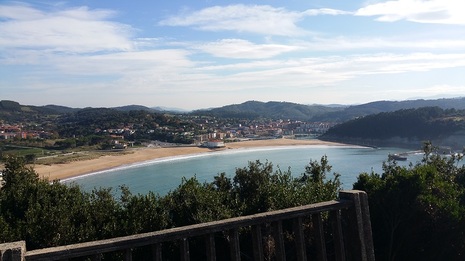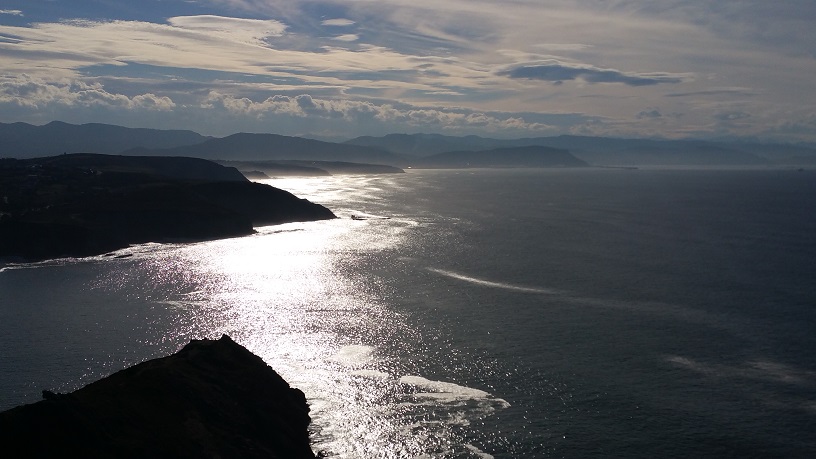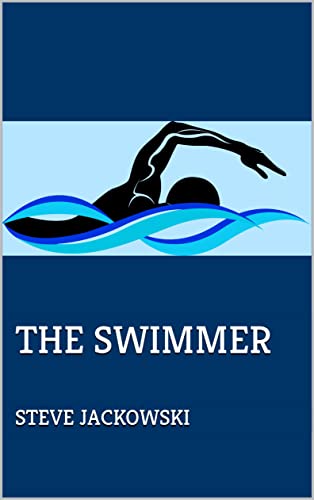 The village of Gorliz from the trail above. Note the river and harbor on the far end of the beach
The village of Gorliz from the trail above. Note the river and harbor on the far end of the beach The coastline here is rugged. It reminds me a bit of Big Sur with its imposing cliffs, precipitous drops to the sea, rocks formations and small islands, and spectacular views. The big difference is the rivers. There's lots of water here and rivers rush from the Pyrenees to the ocean carving wide fertile valleys and creating coves and harbors with beautiful sandy beaches. The beaches and harbors are protected by the huge cliffs to the east and west (remember this part of the coast of Spain faces north).
 The beach at Gorliz - deserted!
The beach at Gorliz - deserted! The beach was impressive - long, and completely deserted, aside from a few naturistes on the east end below the cafe's terrace.
The village of Gorliz has about 5,000 permanent residents. It's effectively a suburb of Bilbao and is the last stop on Bilbao's underground metro line. The bay and beach were formed by the Plentzia River on the west end. There's a protected harbor entrance at the mouth of the river. The large building on the beach path (as seen in the picture at the top of this post), is not a Casino as you might imagine, it's the hospital. In the 1920s, Gorliz was the first place on the Basque coast to set up a salt-water spa for health treatments. Now these are found in many of the towns and villages dotting the coast. Karen and Elaine frequently go to the Thalassotherapy Spas in Hendaye and Saint-Jean-de-Luz.
Re-energized after their coffees, Elaine, Jean-Luc, and Karen thought we might give the hike a try after all.
The climb up the trail from the east end of the beach was more challenging than expected but afforded us impressive views of Gorlitz, its beach, and the Plentzia River. With the rising temperatures and the late October sun, we were grateful for the shade as we ascended the forested trail. As we rounded the corner above the edge of the bay, the views to the west were breathtaking. We kept thinking the trail would flatten out but it kept climbing.
We passed fields of wild crocus, and made our way up to the next highest point where we finally saw the Lighthouse at the End of the World.
The lighthouse itself wasn't particularly spectacular. And while the views to the west were breathtaking, there was no way to see to the east - the part of the cliff that would have afforded that view was overgrown with plants. I must admit to being disappointed. I also thought that it didn't live up to its 'end of the world' billing.
There were also pictures and maps of the area marking additional hiking trails and describing the lighthouse's and the area's history.
The trail starts again behind the lighthouse and climbs another hundred feet or so, passing bunkers and underground galleries complete with cannons built by Franco after the Spanish Civil war in anticipation of an invasion by the allies during WWII. The trail then winds through scenic hills and valleys back to Gorliz.
At this point, though, we were a bit tired. Having climbed the cliffs of San Juan de Gaztelugatxe earlier and adding another thousand vertical feet here, we decided to take the shady service road back to Gorliz as the sun was setting.
An hour and a half later we were home and got cleaned up for a romantic dinner at one of our local favorites, Tantina de la Playa in Bidart.
If you decide to try the trail to the Lighthouse at the End of the World, set your expectations low for the lighthouse itself. As for the rest of the hike, it's definitely worth it: incomparable views, some interesting history, and a somewhat challenging 6.4 km (4 mile), 300 meter (1000 foot) vertical loop. And if it's summer or a warm fall day, don't forget to enjoy the beach and crystal clear waters of the Bay of Plentzia in Gorliz.







 RSS Feed
RSS Feed